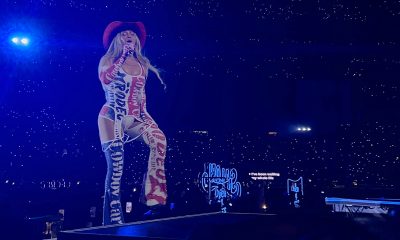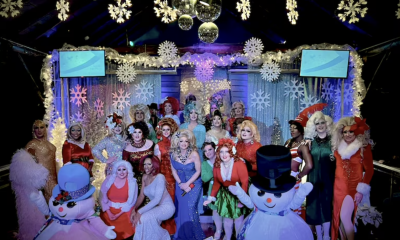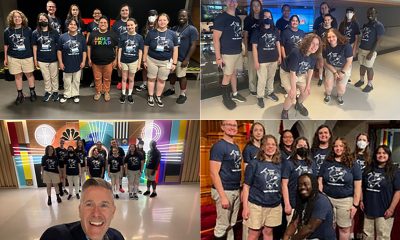a&e features
Baltimore’s ‘Visionary’ curator prepares to step down
For 26 years, Hoffberger has created a loving haven and championed LGBTQ artists
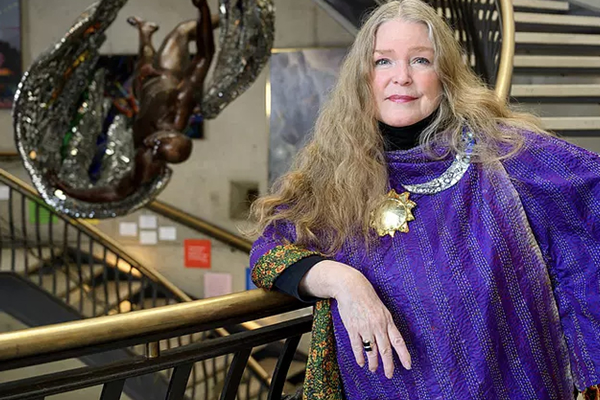
The American Visionary Art Museum in Baltimore has highlighted hundreds of artists since it opened in 1995, and works by LGBTQ artists have featured prominently in both its permanent collection and changing exhibits.
From Andrew Logan’s Cosmic Galaxy Egg sculpture to Robert Benson’s blinged-out Universal Tree of Life to Judy Tallwing’s Prayer for Peace painting, LGBTQ artists have been responsible for some of most memorable creations that visitors will see, whether they know it or not.
This pattern of inclusion is part of the legacy of museum founder, director and primary curator Rebecca Alban Hoffberger, a longtime ally of the LGBTQ community. After 26 years running the museum, Hoffberger announced in July that she plans to retire in March of 2022, and AVAM’s board has launched a search for her replacement.
But unlike some museum directors who have called attention to their recent efforts to promote greater diversity in the range of artists they show, Hoffberger said she has never set out specifically to include a certain percentage of LGBTQ artists, just as she has never set a goal for featuring a certain number of minority or female artists.
She said she simply tries to find the best artists for each show, based on the perspectives they bring and the work they produce. In many cases, she said, she doesn’t necessarily know an artist’s sexual orientation, unless their work is homoerotic or intentionally refers in other ways to their identity.
Hoffberger said her resistance to quotas is not because she’s color-blind or gender-blind.
“I would say I’m color- and race-celebratory,” she said. “There’s a quote by [Canadian writer] Dorothy Maclean: ‘Humankind trend should be to unity, not uniformity.’ That pretty much sums it up. That’s how I feel. Labels like gay or straight or bi, what do they tell you about a person? Not very much. I’m not so interested in people’s sexuality. I’m interested in the person.”
Hoffberger likens curating a museum exhibit to planning a banquet: “If you’re looking to offer…as delicious a feast as possible, it comes naturally that you would have participation by extraordinary people of every stripe.”
Located at 800 Key Highway near the city’s Inner Harbor waterfront, the museum has been designated by Congress as a “national repository and educational center for visionary art,” which is defined as works “produced by self-taught individuals, usually without formal training,” which arise from “an innate personal vision that revels in the creative act itself.”
These creators, sometimes called outsider artists, often try to make sense of the world by making art with whatever materials they have at hand, whether it’s egg shells or toothpicks or more conventional artist supplies.
Hoffberger said she prefers the term visionary artists, or intuitive or self-taught, to ‘outsider.’ But she notes that it makes sense that many LGBTQ individuals turn out to be visionary artists because of the experiences they’ve had in life. She said many members of the LGBTQ community have lived outside the mainstream in one way or another, and that has both fueled their drive to make art and informed the art they make.
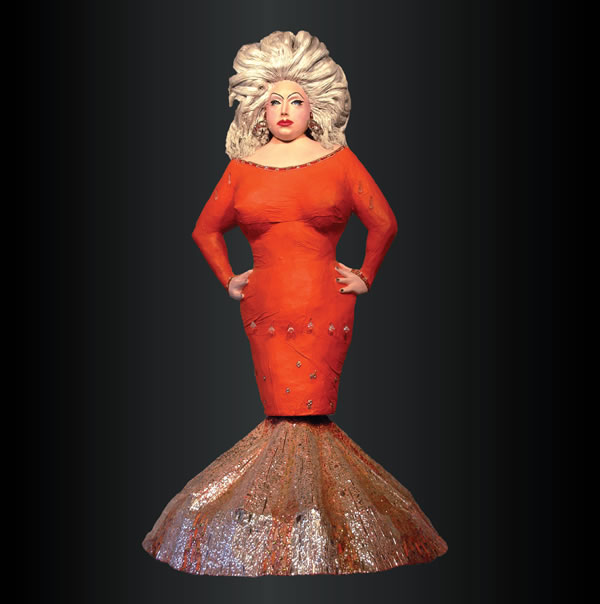
“How about you’re born into a family where all the girls are gorgeous and you’re the fat one? Or you have a deformity? There’s a myriad of ways that people feel out of step,” she said. “When the life experience is too big for words, it often will come out from non-artists as a creative expression for the first time because there are just no words for it.”
This doesn’t mean LGBTQ artists are inherently better than non-LGBTQ artists, she said.
“Better? No. But anyone who feels for any reason like an outsider, who has experience feeling like a stranger, always has a more in-depth take at reality because they are on some level on the outside…The point is that people who have that little bit of knowing what it is like to be outside the circle actually often will have a perspective that helps evolve and draw a circle.”
Something happens to people when they aren’t from the “established pack,” she said, that makes them look at the world differently and react differently and perhaps get more creative.
“When you’re not from the pack…when you’re forced out of conventional thinking because people are giving you pretty clear signals that you’re not like them in ways that they may even be hostile to, then you start to think more deeply because you can’t coast on being accepted in the same way. It’s not as easy.”
Hoffberger points to the work of gay filmmaker John Waters and his ability to capture what it’s like to live outside the mainstream.
“That’s what I think John Waters has done so unbelievably well,” she said. “He didn’t shock just to shock. He always had this softness for seeing value in people that other people would never have focused on. And in doing that, you sense that you are with someone who’s going to give you a break. That’s why he has yet another generation of fierce fans. This is a person who draws a big circle around the human family, and we’re living in a time when people are getting more and more narrow…So you want to be in the camp of championing more people, the beauty of more people, and the more diverse the better.”
As director and curator, Hoffberger said, she seeks out the best work she can find by visionary artists to incorporate in the museum’s exhibits. But rather than presenting works of visionary art as objects unto themselves, she curates exhibits that combine art, science, philosophy and humor, with an organizing theme for each show and an underlying focus on social justice and betterment.
In some cases, AVAM has explored themes that touch on gender, gender rights and human sexuality, including a 2005-2006 show entitled “Race, Class and Gender: 3 Things that Contribute ‘0’ to CHARACTER (Because being a Schmuck is an equal opportunity for everyone!) For exhibits such as that, Hoffberger said, works by LGBTQ artists can be particularly appropriate due to the artist’s point of view.
In other exhibits, she has focused on issues ranging from climate change to hunger to public health. AVAM’s next major exhibit, scheduled to open Oct. 9 and run until Sept. 4, 2022, is entitled “Healing & The Art of Compassion (and the Lack Thereof.)
Hoffberger said she doesn’t think sex or race are good ways to assess people.
“I don’t think your sexual orientation, I don’t think your color, I don’t think your religion, conveys any quality of character whatsoever,” she said. “That’s why I did that show, Race, Class and Gender. Three things that contribute zero to character but everybody is talking about all the time. I would think it would be more fair, since they’re approximately 50 percent of the population, if there were more women leaders. But do I think that because you are a woman leader you are going to be more spectacular just because of having a vagina? No, absolutely not. None of those things mean much to me, frankly.”
That goes for artists as well as elected leaders, Hoffberger said.
“I don’t even like it when I can look at a work of art and go, I know a woman did this. I really don’t like that,” she said. “I’d rather it just be kind of a soul, with different clothes on. I like magnificent souls, with whatever. And in that celebration, you have a great tenderness to be open to wherever that soul and beauty will manifest.”
AVAM has become a magnet for LGBTQ visitors, she said, because it’s a place where they feel comfortable with the art and the other patrons.
“What I love about the museum is that it is such a haven,” she said. “There are so many young teens that are transitioning, who come because, whether you’re wearing a burka or whatever, there’s a safety in being in our museum because there’s such a welcoming, loving vibe. You can see people who you can relate to not only walking through the museum but also in the art.”
Following are some of the LGBTQ artists whose work is or has been featured at the American Visionary Art Museum:
Andrew Logan, (1945- ) His works at AVAM: A 10-foot-tall sculpture of Divine, a tribute to the drag performer who starred in “Pink Flamingos,” “Multiple Maniacs,” “Hairspray” and other movies by filmmaker John Waters; Black Icarus, a figure suspended above the museum’s main staircase, and the Cosmic Galaxy Egg, an eight-foot-high sculpture on a plaza outside the museum’s Jim Rouse Visionary Center, inspired by the deep space images revealed by Hubble Telescope transmissions. Hoffberger is hoping to add a fourth work by Logan, a sculpture of the mythical creature Pegasus.
Logan was born in 1945, the third of five brothers in a family with one younger sister. In 1967 Logan graduated from the Oxford School of Architecture and spent one year in the United States working for the Virginia Historic Landmarks Commission. At the age of 27, Logan gained notoriety as the co-founder, along with Baltimore’s Divine, of the Alternative Miss World contest, an inclusive beauty contest open to transvestites, the old and the young, men and women. His contest emphasized imagination and the radiance of beauty from within. In 1979, Andrew’s Alternative Miss World contest fought off legal action from another event with the help of a budding young defense barrister – future British Prime Minister Tony Blair.
Logan is a tap dance and yoga aficionado and a prolific self-taught artist whose sculptures, mirrored jewelry, costumes, stage sets, and performance pieces have garnered a wide audience. He creates his art by using materials that are at hand, often incorporating mirror fragments and fabric remnants, and adding realistically sculpted heads and bodies. In the 1980’s Logan founded his own museum in Berriew, Wales, to house and display a portion of his work.
“The mirror of the universe has been my life for almost forty years,” the museum’s website quotes Logan as saying. “It has an energy like no other material. I have played with mirrors to create monuments, portraits, wall pieces and sculptural jewelry…My life is an artistic adventure.”
Judy Tallwing, (1945- ). Her work at AVAM: A painting entitled Prayer for Peace is part of the museum’s permanent collection. It was a gift of the artist in memory of Sashie Helene Hyatt.
Tallwing is an Apache elder, leatherwoman and multi-media artist who won the first International Ms. Leather contest in 1987. Born in Glendale, Ariz., Tallwing has childhood memories of living in the desert with her parents and seven half brothers and sisters, helping to hunt rattlesnakes, and selling rocks by the roadside. Like many Native American children, Tallwing attended both a Catholic girls’ school and Indian School. She has six children, 23 grandchildren, and seven great grandchildren.
Tallwing started making art as far back as she can remember. “We didn’t call it art, we called it making things to sell along the road to help the family survive. I used to watch my grandmother, grandfather, and my mother all doing various forms of what I now know is art, to sell, and I wanted to help.” The first thing of hers that sold was a bee sitting on a flower, painted on a rock. It sold for 25 cents.
In her youth, Tallwing did a little bit of everything, from running her own construction and leather production companies to being the executive director of a domestic violence victims’ program and running an animal rescue operation for 13 years. “I think an ‘aha moment’ for me was realizing I could go to college, even without much other schooling.”
Starting college at age 32 changed her life; she now holds both an associates’ and bachelor’s degree. She travels to what she calls “power places” and brings back tiny fragments from those places to put in every painting or sculpture that calls for them, including copper, silver, turquoise, garnet, prayer ashes, and minute crystal prayer beads.
“I love trying to bring the stories I’ve heard to life and to add the spiritual aspects of the stories through the medicine of different elements of nature,” she has said. “Each thing that lives on the earth has its own energy and I try to put those energies together to create a healing.”
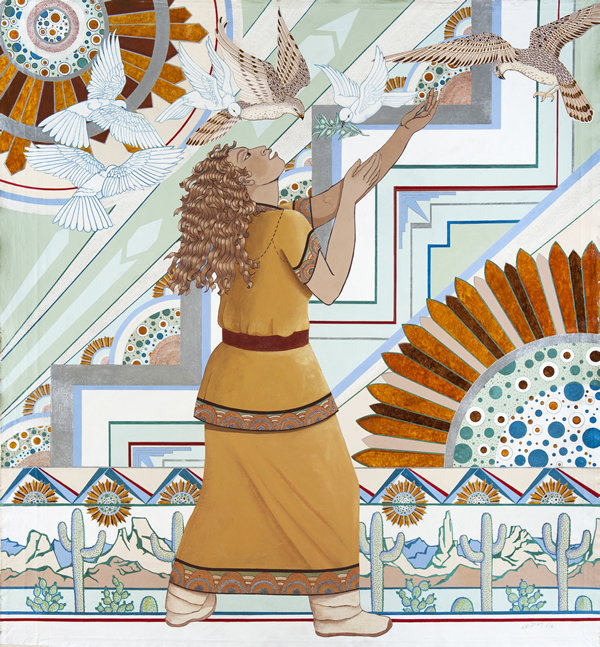
Ingo Swann, (1933–2013). His work at AVAM: The Light Bringer, a painting in the museum’s permanent collection.
Swann is best known as a pioneer in the field of remote viewing, the practice of seeking impressions about a distant or unseen target, also described as “sensing” with the mind. Swann’s high rate of success in this field led him to co-create, along with Harold Puthoff and Russell Targ, the Stanford Research Institute of Remote Viewing and the CIA Stargate Project, launched to investigate psychic phenomena in military and domestic intelligence applications.
Swann was born high in the Rocky Mountains in Telluride, Colo., on Sept. 14, 1933. His father was a truck driver and he had two sisters. He often spoke of the beauty of his surroundings as a child, particularly the crystal-clear skies where he could see the Milky Way each night.
Swann wrote that he first experienced leaving his body at the age of three, during an operation to remove his tonsils. At that time he also became aware of seeing “butterfly lights” around people, plants, and some animals, which he later learned were auras. By nine, he wrote that he’d remotely traveled to the Milky Way. He famously claimed to have sent his consciousness to Jupiter prior to the arrival of NASA’s Voyager satellite probe and accurately described many of the planet’s features, including Jupiter’s then-unknown rings.
Swann’s paintings express his passion for exploring the mysteries of the universe and recapture his visions from leaving his body, remote viewing, and seeing auras. Swann was also a musician and a writer of several books, including his autobiography, “Penetration: The Question of Extraterrestrial and Human Telepathy” (1998). He died on Jan. 31, 2013 in New York City.
Bobby Adams (1946 – ). His work at AVAM: His photographs, scrapbooks and shrines have been featured in three exhibits.
Adams is a multimedia artist and a member of filmmaker John Waters’ group known as the Dreamlanders. He was born Robert Reid Adams on Feb. 15, 1946 in Dallas, and grew up in Baltimore. His father, a former boxer and strict disciplinarian, operated a floor sanding business in Dundalk. His “beloved and gentle” mother taught school and would eventually die by suicide in 1976.
Adams graduated in 1964 from Sparrows Point Senior High School and was able to avoid being sent to Vietnam because of a hearing problem. He became a pirate radio DJ in the late 1960s, playing at gatherings around Baltimore and spinning records for a station he dubbed W.E.E.D. He assembled elaborate scrapbooks stuffed with psychedelic collages and philosophical, often humorous, musings to illustrate his DJ patter and circulate among listeners at gigs.
In 1970, he began working with John Waters, who filmed “Pink Flamingos” at the Baltimore County farm where Adams was living. Ever since, Adams has been the filmmaker’s unofficial documentarian, taking photographs on film sets and chronicling the exploits of Waters’ band of renegades, the Dreamlanders. “I never learned how to do the camera,” notes Adams. “I just point and shoot. My approach is simple: I start with love, and the camera sees it.”
A self-professed Christmas addict, Adams makes hundreds of personalized, handmade, labor-of-love holiday cards for friends and family each year. Inspired in part by Waters’ own art making and an Edward Kienholz exhibition he chanced upon, Adams began making art in 1996, after the loss of his toy poodle, Odie. He created 50 multimedia tribute pieces to Odie and installed them throughout his waterfront cottage. Before it was displayed at AVAM, Adams’s art had never been exhibited publicly. When asked if he ever had an unrealistic hope fulfilled, he said, “Yes, being included in this show.”
Robert E. Benson, (1930 – ). His work at AVAM: The shiny Universal Tree of Life visible near the museum’s main entrance on Key Highway; the fart machine in the museum’s Flatulence exhibit; the ocean beneath Andrew Logan’s Black Icarus sculpture and the sky above it, and other creations.
Benson is a popular classical music radio host who became a prolific visual artist late in life. Born in Chicago, he served in the Army from 1951-1953 as enlisted secretary to General Mark Clark, commander-in-chief of the Far East Command. From 1953-1955 he worked for the B&O Railroad as secretary to the Manager of Industrial Development, and for two years was Assistant Manager of the Baltimore Symphony Orchestra.
Benson’s radio career began in 1958 when he was program director of WFDS-FM, which two years later became WBAL-FM. He was program director and chief announcer there until 1974, when he became Director of Audience Development for the Baltimore Symphony.
In 1975, Benson became coordinator of the Maryland State Arts Council’s Community Arts Development program working to organize county arts councils in all 23 counties of Maryland. He also was in charge of grants to music organizations and individuals, and retired from his state job in 1995. In 1979 he became morning announcer for WBJC-FM, where he remained until 1986. For 10 years beginning in 1987, Benson did programming and announcing for WJHU (now WYPR). He has collected recordings for many years, with particular interest in historic performances. He has written reviews for numerous publications, including Forecast FM, Hi Fi Stereo Buyers Guide, High Fidelity and Stereophile.
Benson lives in Glen Burnie, Md., where he grows orchids in his “underground” greenhouse, a hobby of three decades, and listens to music on his elaborate surround sound system. Since 2004 he has been working with mirrors and stained glass, creating varied art and decorative pieces.
Andrey Bartenev, (1969 –). His work at AVAM: In 2007, Bartenev won first prize in the museum’s “Bra Ball,” for his black and white rubber costume and performance.
Bartenev is a Russian performer, sculptor and experimentalist who won the Alternate Miss World pansexual beauty pageant in 2018 as Miss UFO. He was born on Oct. 9, 1969 in the northernmost Arctic Circle city of Norilsk in Siberia, an industrial town famous for its reserves and production of aluminum.
Bartenev recalls “three months of total darkness, one month of really hot summer, and 15 days each for spring and autumn.” His only sibling, a sister, was 12 years older. Bartenev’s father was a coal mining engineer and his mother was an industrial safety engineer. Both worked long hours, giving Bartenev free reign to decide how he spent his time alone.
At three, Bartenev loved scissors and began to cut images and patterns from books. “We made all our toys out of snow.” At an early age, Bartenev would organize parties for his friends who were also left alone, getting them to bring over all their pets. He used plastic to sculpt little “castles” for his mice and hamsters, and made costumes for his cats and dogs.
At 16, Bartenev moved with his family to Sochi in the south of Russia — “like Miami with mountains.” In college he studied theater and directing, graduating with high honors. His first job was directing a children’s theater near Chechnya. He also danced and performed in a local cabaret.
Moving to Moscow in 1990, Bartenev supported himself doing collages and graphics and competed in the Big Arts Festival at the Baltic Sea in 1992, where he met one of the judges, Andrew Logan, co-founder of the Alternative Miss World contest. Bartenev made a Snow Queen costume out of papier-mâché that won the top prize. Logan invited him to compete in the Alternative Miss World contest in 1995, 1998, and 2002 in London. There, Bartenev also created programs for the popular BBC children’s TV show, “Blue Peter” and re-staged his original performance show, “Botanic Ballet.” In 2007, he brought his talents to Baltimore and won first prize in AVAM’s “Bra Ball.” He has said his idea of perfect beauty is his childhood vision of “black sky and white snow.”
James Franklin Snodgrass (1922–2000). His work at AVAM: An untitled painting in the permanent collection, the gift of Robert Civello.
Snodgrass was born in Harford County, Md. in 1922. The son of a schoolteacher, he painted mannequins and traveled throughout the United States after graduating from college. During World War II, he declared himself a conscientious objector and worked as an ambulance driver for a Quaker society.
Appearing on television game shows became a peculiar “hobby” for Snodgrass, who won prize money on several occasions. In the late 1950s, he became the focus of public attention after he exposed fraudulent practices on the popular quiz show, Twenty-One. His story inspired Robert Redford’s 1994 film, “Quiz Show.”
Afterwards, Snodgrass grew increasingly reclusive and focused on his art. He was evasive, even secretive, about the untitled painting in AVAM’s collection, which took many years to complete. He died from cancer in early 2000.
Located at 800 Key Highway, the American Visionary Art Museum is open from 10 a.m. to 5 p.m. Wednesdays through Sundays. Advance online purchase of a timed ticket is required to visit the museum. Visiting just the museum store, Sideshow, is free and does not require purchase of a ticket.
a&e features
From Prohibition to Pride: Queering the District podcast reveals local LGBTQ history
The new podcast explores the hidden history and enduring impact of queer spaces in Washington, D.C.
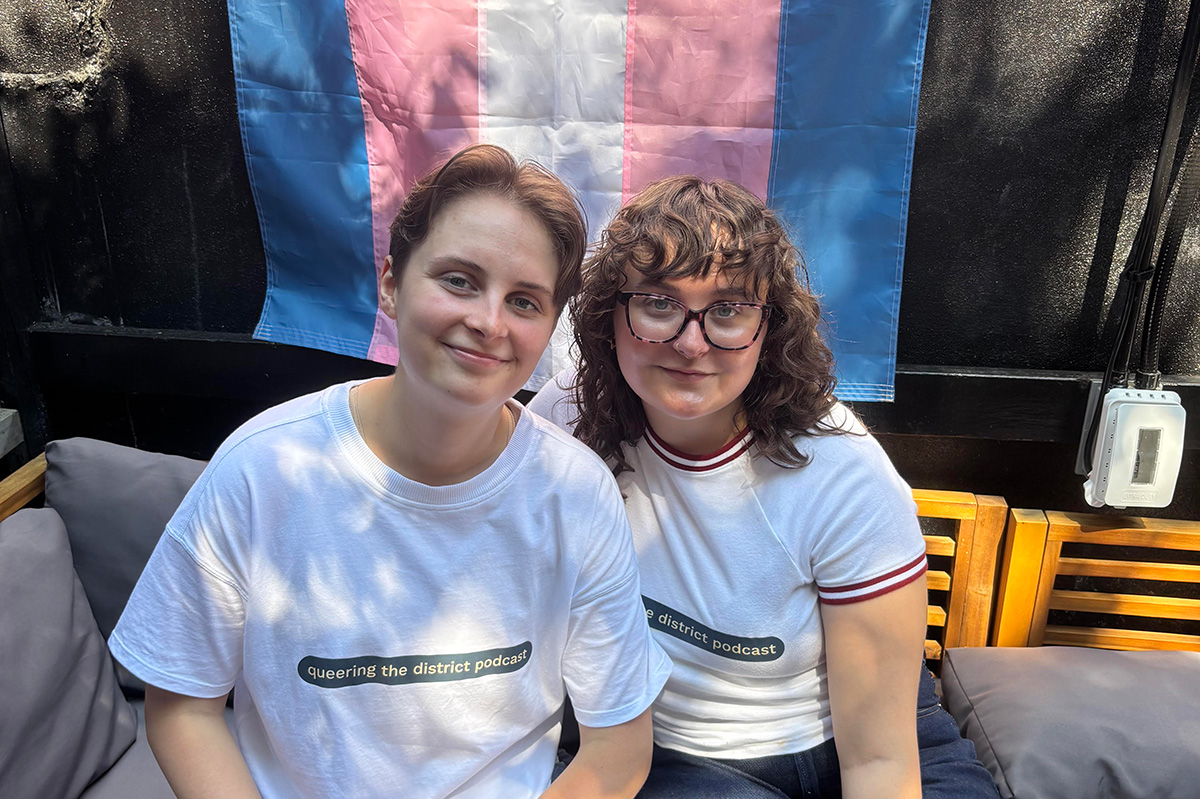
On June 25, as Pride month inched toward its end, three queer creators launched an ambitious project to honor the spaces that built D.C.’s LGBTQ community—and connect them to today’s queer life. The first episode of their podcast, Queering the District, hit streaming platforms that day, aiming to spotlight what host and co-creator Abby Stuckrath calls “third places”: bars, clubs, and gathering spots that have served as hubs for queer life across the city.
Each episode of the 10-part series delves into a different piece of D.C.’s queer past—from landmark clubs to untold personal stories—told through the voices of drag legends, activists, DJs, historians, and patrons who lived it. The show also threads together personal experiences from today’s community, bringing the listener on an auditory journey from Prohibition-era speakeasies to contemporary nights out at places like As You Are or Saints & Sinners.
Abby Stuckrath, alongside her sibling Ellie Stuckrath, and producer Mads Reagan, make up the podcast’s creative team. A recent journalism graduate of American University, Abby told the Blade that her passion for queer storytelling began during college—and that D.C. itself played a defining role in shaping her queer identity.
“I went to American University. I graduated last year and studied journalism. When I was in school, I always wanted to focus on queer stories – especially in D.C., because I’m from Denver, Colorado, I’ve never lived in a place like this before. D.C. has always just kind of been a place I call home when it comes to my queer identity.”
But breaking into the media to tell those stories wasn’t easy. Stuckrath quickly learned that editorial support—and funding—for queer-focused projects is limited. So she decided to do it her own way.
“I kind of found out that if you want to tell stories, you kind of have to do it on your own– especially when it comes to queer stories. There’s not a lot of people begging for us to talk about queer people and to pay you for it. So I was like, ‘Okay, let’s just do it on my own.’”
The idea for the podcast first took root in conversations with Ellie, Abby’s sibling and biggest supporter. Ellie had also moved to D.C. to find more space to explore and express their queer and gender identities. Together, the two began shaping a vision that would combine storytelling, sound design, and grassroots community input.
“I was like, ‘I don’t know what exactly I want to do yet, but I want it to be queer, and I want it to be about D.C., and it’s going to be called Queering the District, and we’re going to find out what that means.’ And Ellie is my biggest supporter, and my best friend. And they were like, ‘Hell yeah. Like, let’s do this.’ And so we decided to just do it together.”
The name stuck—and so did the mission. The team began researching queer D.C. history and found a city overflowing with stories that had rarely been documented, especially in mainstream archives.
“We started looking up the history of queer culture in D.C., and it kind of just clicked from there,” Stuckrath said. “I did not know anything about how rich our history is in the city until one Google search, and then I just kept learning more and more. I was kind of pissed because I studied gender studies in school in D.C. and didn’t learn shit about this.”
Season one focuses on the role of third places—non-work, non-home spaces where queer people could gather, exist fully, and build community.
“Third places have always been the epicenter of queer life… places outside of just your own personal home, because sometimes that isn’t a safe place. And of course, the work most commonly in the past and still today, isn’t a safe place for queer people to be full of themselves. So like, bars were the first place for queer people to really thrive and meet each other.”
To make the show participatory, Queering the District includes a twist: a voicemail line where anyone can call in and share a memory or question. The team calls the phone “Fifi”—a nod to the kind of retro guestbooks often used at weddings, but reimagined for queer nightlife and history.
“We wanted to find a way for people to share their stories with us anonymously… so even though we start in Prohibition, we wanted to connect it to now—like, those people who were singing jazz to each other in a white queer bar are connected to you singing karaoke on a Sunday night at your favorite gay bar. We’re all interconnected by this third place of queer bars in D.C.”
Those connections are emotional as well as historical. While building the series, one realization hit Stuckrath particularly hard: the immense loss of queer spaces in D.C., especially in neighborhoods that have since been heavily redeveloped.
“Every time I go to a Nats game, I think about, well, this just replaced five gay bars that used to be here. It used to be the home of Ziegfeld’s… Tracks, which was almost 2,000 square feet, with a volleyball court in the back, a fire pit, and iconic light show. I just didn’t know that we had that, and it made me sad for the queer elders that are in our city now who walk the streets and don’t see all those places they used to call home.”
That sense of loss—alongside the joy and resilience of queer community—is what the show aims to capture. As the podcast continues, Abby hopes it serves as both a celebration and an educational tool, especially for young LGBTQ people arriving in D.C. without realizing the queer foundations they’re walking on.
“D.C. is a unique city, and specifically young queer people who are hoping to move to the city—to know that you’ve got to know your history to be here. I hope this serves as an easier way for you to consume and learn about queer history, because queer history defines how we move in life.”
And for all the voices still left out, Abby is clear: this podcast is an open door, not a final word.
“This is a perfectly imperfect podcast. We should just be a starting point. We shouldn’t be the ending point.”
New episodes of Queering the District drop every Wednesday on all major platforms.
a&e features
Doug Spearman takes his chance
‘Noah’s Arc: The Movie’ debuted on Paramount+ last month
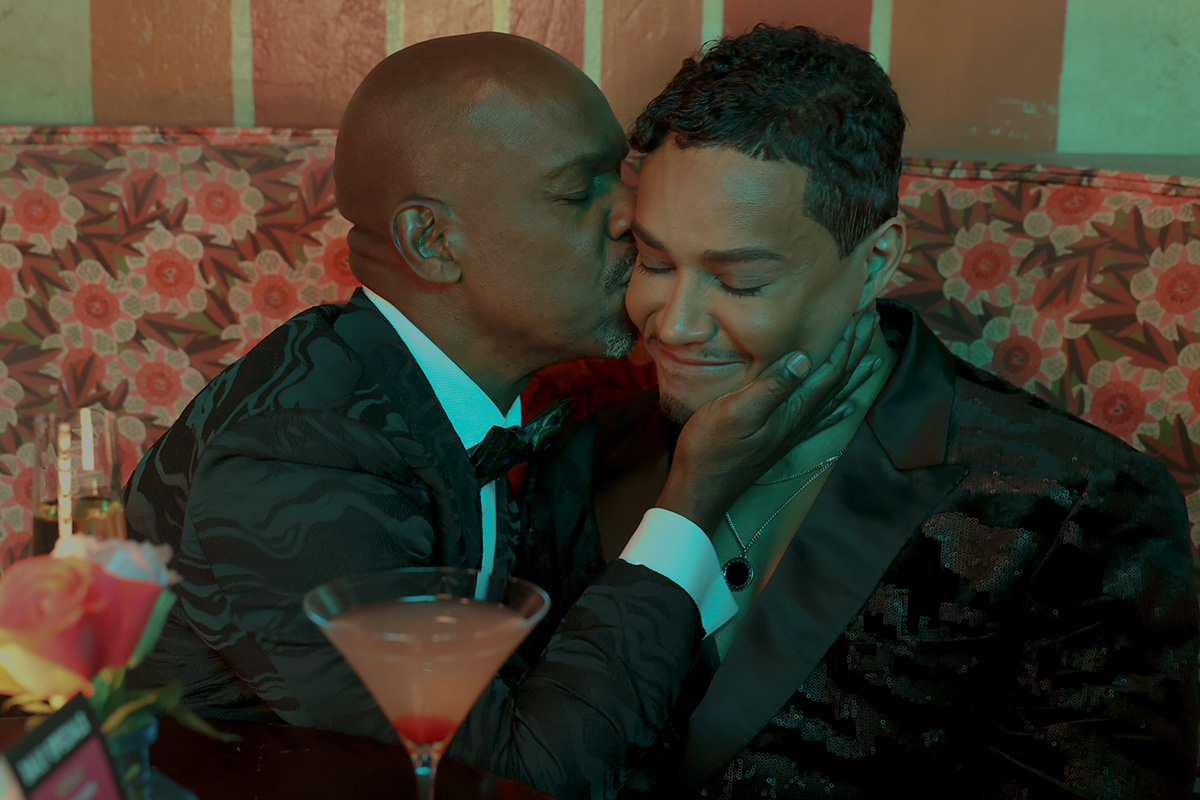
There’s no question that when Patrik-Ian Polk’s series “Noah’s Arc” premiered on Logo 20 years ago, it was a groundbreaking creation. The story of a group of Black gay men and their wonderful friendship. The titular arc was that of the cute main character, Noah (Darryl Stephens), and his close-knit circle of friends, including Chance played by gay actor Doug Spearman. This compelling and loving fraternity may, in fact, be what brought viewers back repeatedly, including a 2008 movie, “Noah’s Arc: Jumping the Broom,” as well as the 2020 “Noah’s Arc” short, and now, a new full-length feature “Noah’s Arc: The Movie,” debuting on Paramount+ on June 20. In the movie, filled with equal measures of laughs and tears, Chance, who has faced a devastating loss, finds his dependable friends there, ready to support and comfort him at a moment’s notice. I had the pleasure of speaking with Spearman the morning of the streaming premiere of “Noah’s Arc: The Movie.”
WASHINGTON BLADE: Doug, since the early 2000s, when the “Noah’s Arc” series premiered on Logo, you have been playing the character of Chance, including in the latest installment, “Noah’s Arc: The Movie.” What was it about Chance that appealed to you as an actor?
SPEARMAN: When Patrik (-Ian Polk) called me to ask me to play him (Chance), I was at JFK airport in the baggage claim, waiting for a suitcase. He explained what the part was. The thing that stuck out to me was the fact that Chance was in a long-term relationship with another Black man. And, they had a child; they had a 4-year-old daughter named Kenya. I had never seen two Black gay men raise a child on TV before. I thought it was the most revolutionary thing I’d ever seen. I immediately thought I’ve got to do this because that was something nobody had seen. I thought it was incredibly important to take the part.
BLADE: “Noah’s Arc: The Movie” was, once again, written and directed by Patrik-Ian Polk, who you just mentioned, is the creator of the entire franchise. What’s the secret to your long-standing working relationship?
SPEARMAN: [Laughs] the whole team, all of us, are like a band of brothers. We fight like brothers, we come together like brothers, we hash things out, we talk, because we’re all very different from our characters. I think the challenge of playing these guys and then uplifting these men, playing a part, especially something written by Patrik, is like solving a math equation. There’s always a challenge that’s enjoyable for me as an actor: to try to find out what it is that Patrik wants, and then how do I do it.
BLADE: I think you do a very good job of it.
SPEARMAN: Thank you very much
BLADE: In the years between “Jumping the Broom” and the new full-length movie, many changes have occurred, and the story addresses some of them, including gay widowhood, which is something that the aging community is now confronting, as well as mental health issues. Please say a few words about how you approached those subjects in the new movie.
SPEARMAN: I had a lot of loss in my life, right before we started shooting. Two months before we started shooting the first series, my mother died. I was going through the grief process through that whole first season. Since then, I’ve lost a lot of people in my life. In fact, when we started shooting the second season, the second week we were shooting, my ex died of a heart attack. I was having to fold that into what I was doing with my life on the set and off the set. You’ve got to show up and you’ve got to do your work. The first two seasons of “Noah’s Arc” are always tinged with the memory of grief. So, when I had to deal with the death that Chance faces (in the new movie), which is a significant death in his life, it wasn’t that hard to reach back, especially the scene in the graveyard. It was something that I unfortunately could pull from personal experience.
BLADE: Shifting gears, the movie features delightful cast surprises, including Jasmine Guy and TS Madison. Did you have a chance to interact with either or both when they were on set?
SPEARMAN: No, I didn’t have any scenes with Jasmine, and I missed her. I wish I had gotten to see her because I actually got to direct Jasmine for a CBS promo shoot for “Queen,” back in the early ‘90s. I had a huge crush on her when she was on “A Different World.” So, I really would have liked to reconnect. But TS and I got to see each other every day because I was in all her scenes. It was extraordinary being around somebody like that. That is one outspoken woman!
BLADE: Even though Beyoncé never makes an appearance in the movie, there’s a lot of talk about her. Would you say you are a Beyoncé fan?
SPEARMAN: Yes! I’m breathing! Yes, I’m a Beyoncé fan. I actually got the chance to meet her. I knew her mom. Her mom was extraordinary to me. She is in the second movie I directed. She also gave us a wedding gown to use in the very first scene of the movie. That family is extraordinarily important to me. Not only just to be a fan, but to be somebody who’s gotten to know them and work with them and see how hard they work. I don’t think anybody works as hard as Tina or Beyoncé.
BLADE: There was a recent news item about gay actor Benito Skinner of the Amazon Prime series “Overcompensating” being told not to bother auditioning for straight roles. As an out actor yourself, how important do you think it is for queer characters to be portrayed by queer actors, and vice versa?
SPEARMAN: Being queer is a multifaceted identity. There’s no one kind of queer person. I think finding the best actor that’s your first circle of casting. I think one of the joys about being an actor is that you get to play different parts. I play straight guys all the time. Dads and husbands and things like that. I think a lot of people are told not to do it. In fact, I wouldn’t be Chance if the actor who was originally cast as Chance hadn’t been pulled out of the series by his agents because they didn’t want him to play a gay character.
BLADE: That’s amazing! Thank you for sharing that. Without giving away too much, the ending of the movie is a little ambiguous, even ending with a question mark. If there was a “Noah’s Arc: The Movie” sequel, would you come back for that?
SPEARMAN: Yeah! A lot of it would depend on what Chance’s journey is going to be like. Patrik and I have conversations like that all the time. He’s very interested and supportive of input. I hope I would be, as we all would be, part of the creative growth with these characters. They live in Patrik’s head, and he writes them, but we’re the ones who have to flesh them out. It’s a conversation, it’s always a conversation.
BLADE: You are currently performing in Molière’s “The Imaginary Invalid” as part of the New Orleans Shakespeare Festival at Tulane. What has this experience been like for you?
SPEARMAN: It’s extraordinary! I started on stage when I was seven. There’s nothing like working with a live audience and having that immediacy. I’m working with an extraordinarily talented cast in a really great play, and I have some of the best scene partners I could ever want.
BLADE: Are there any upcoming film or TV projects you’d like to mention?
SPEARMAN: I’m still a writer, and I’m still a director, and I’ve still got scripts that I would like to make. I have a little something that’s a cross between “Treme” and “Bridgerton” that I want to do. I’m always trying to figure out what the next thing is.
a&e features
Visit Cambridge, a ‘beautiful secret’ on Maryland’s Eastern Shore
New organization promotes town’s welcoming vibe, LGBTQ inclusion
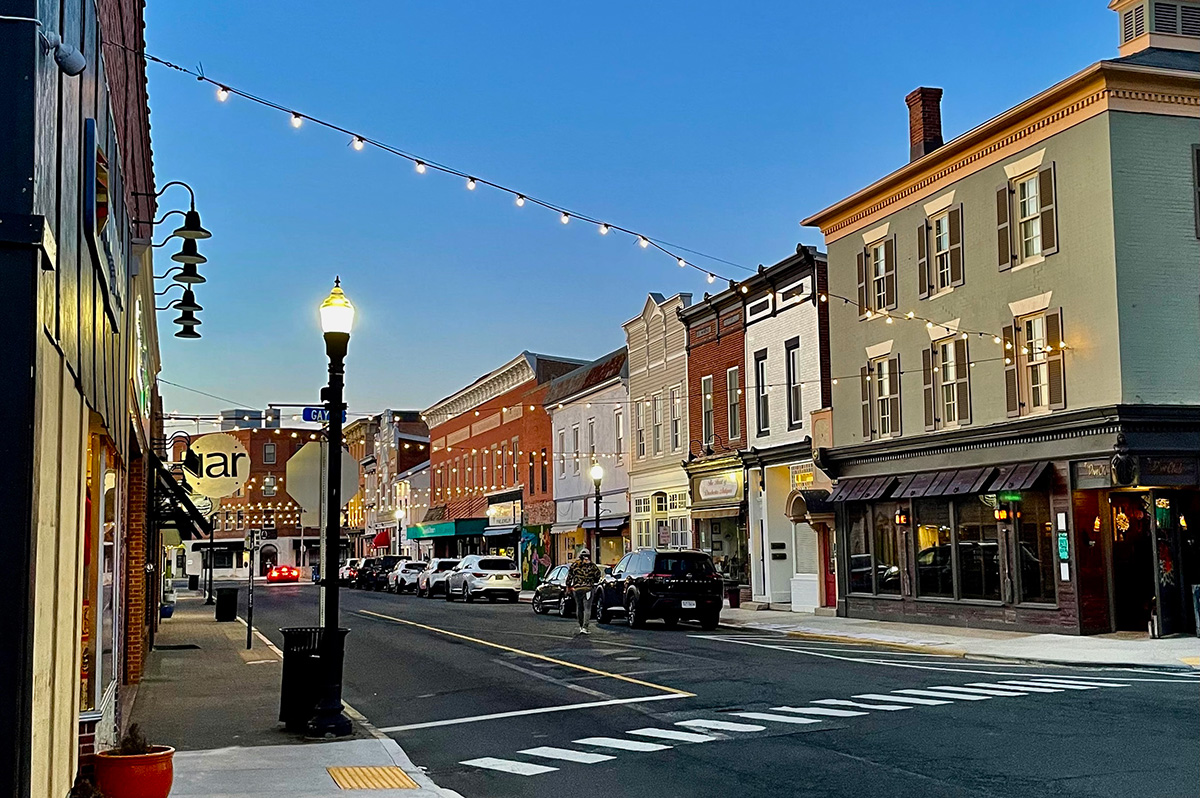
CAMBRIDGE, Md. — Driving through this scenic, historic town on Maryland’s Eastern Shore, you’ll be charmed by streets lined with unique shops, restaurants, and beautifully restored Victorian homes. You’ll also be struck by the number of LGBTQ Pride flags flying throughout the town.
The flags are a reassuring signal that everyone is welcome here, despite the town’s location in ruby red Dorchester County, which voted for Donald Trump over Kamala Harris by a lopsided margin. But don’t let that deter you from visiting. A new organization, Proudly Cambridge, is holding its debut Pride event this weekend, touting the town’s welcoming, inclusive culture.
“We stumbled on a beautiful secret and we wanted to help get the word out,” said James Lumalcuri of the effort to create Proudly Cambridge.
The organization celebrates diversity, enhances public spaces, and seeks to uplift all that Cambridge has to share, according to its mission statement, under the tagline “You Belong Here.”
The group has so far held informal movie nights and a picnic and garden party; the launch party is June 28 at the Cambridge Yacht Club, which will feature a Pride celebration and tea dance. The event’s 75 tickets sold out quickly and proceeds benefit DoCo Pride.
“Tickets went faster than we imagined and we’re bummed we can’t welcome everyone who wanted to come,” Lumalcuri said, adding that organizers plan to make “Cheers on the Choptank” an annual event with added capacity next year.
One of the group’s first projects was to distribute free Pride flags to anyone who requested one and the result is a visually striking display of a large number of flags flying all over town. Up next: Proudly Cambridge plans to roll out a program offering affirming businesses rainbow crab stickers to show their inclusiveness and LGBTQ support. The group also wants to engage with potential visitors and homebuyers.
“We want to spread the word outside of Cambridge — in D.C. and Baltimore — who don’t know about Cambridge,” Lumalcuri said. “We want them to come and know we are a safe haven. You can exist here and feel comfortable and supported by neighbors in a way that we didn’t anticipate when we moved here.”
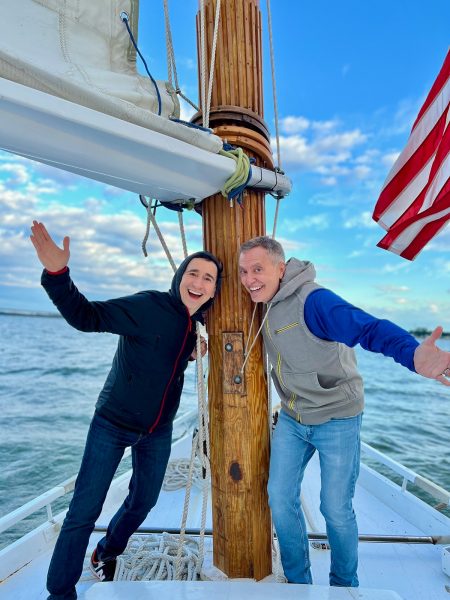
Lumalcuri, 53, a federal government employee, and his husband, Lou Cardenas, 62, a Realtor, purchased a Victorian house in Cambridge in 2021 and embarked on an extensive renovation. The couple also owns a home in Adams Morgan in D.C.
“We saw the opportunity here and wanted to share it with others,” Cardenas said. “There’s lots of housing inventory in the $300-400,000 range … we’re not here to gentrify people out of town because a lot of these homes are just empty and need to be fixed up and we’re happy to be a part of that.”
Lumalcuri was talking with friends one Sunday last year at the gazebo (affectionately known as the “gayzebo” by locals) at the Yacht Club and the idea for Proudly Cambridge was born. The founding board members are Lumalcuri, Corey van Vlymen, Brian Orjuela, Lauren Mross, and Caleb Holland. The group is currently working toward forming a 501(c)3.
“We need visibility and support for those who need it,” Mross said. “We started making lists of what we wanted to do and the five of us ran with it. We started meeting weekly and solidified what we wanted to do.”
Mross, 50, a brand strategist and web designer, moved to Cambridge from Atlanta with her wife three years ago. They knew they wanted to be near the water and farther north and began researching their options when they discovered Cambridge.
“I had not heard of Cambridge but the location seemed perfect,” she said. “I pointed on a map and said this is where we’re going to move.”
The couple packed up, bought a camper trailer and parked it in different campsites but kept coming back to Cambridge.
“I didn’t know how right it was until we moved here,” she said. “It’s the most welcoming place … there’s an energy vortex here – how did so many cool, progressive people end up in one place?”
Corey van Vlymen and his husband live in D.C. and were looking for a second home. They considered Lost River, W.Va., but decided they preferred to be on the water.
“We looked at a map on both sides of the bay and came to Cambridge on a Saturday and bought a house that day,” said van Vlymen, 39, a senior scientist at Booz Allen Hamilton. They’ve owned in Cambridge for two years.
They were drawn to Cambridge due to its location on the water, the affordable housing inventory, and its proximity to D.C.; it’s about an hour and 20 minutes away.
Now, through the work of Proudly Cambridge, they hope to highlight the town’s many attributes to residents and visitors alike.
“Something we all agree on is there’s a perception problem for Cambridge and a lack of awareness,” van Vlymen said. “If you tell someone you’re going to Cambridge, chances are they think, ‘England or Massachusetts?’”
He cited the affordability and the opportunity to save older, historic homes as a big draw for buyers.
“It’s all about celebrating all the things that make Cambridge great,” Mross added. “Our monthly social events are joyful and celebratory.” A recent game night drew about 70 people.
She noted that the goal is not to gentrify the town and push longtime residents out, but to uplift all the people who are already there while welcoming new visitors and future residents.
They also noted that Proudly Cambridge does not seek to supplant existing Pride-focused organizations. Dorchester County Pride organizes countywide Pride events and Delmarva Pride was held in nearby Easton two weeks ago.
“We celebrate all diversity but are gay powered and gay led,” Mross noted.
To learn more about Proudly Cambridge, visit the group on Facebook and Instagram.
What to see and do
Cambridge, located 13 miles up the Choptank River from the Chesapeake Bay, has a population of roughly 15,000. It was settled in 1684 and named for the English university town in 1686. It is home to the Harriet Tubman Museum, mural, and monument. Its proximity to the Blackwater National Wildlife Refuge makes it a popular stop for birders, drawn to more than 27,000 acres of marshland dubbed “the Everglades of the north.”
The refuge is walkable, bikeable, and driveable, making it an accessible attraction for all. There are kayaking and biking tours through Blackwater Adventures (blackwateradventuresmd.com).
Back in town, take a stroll along the water and through historic downtown and admire the architecture. Take in the striking Harriet Tubman mural (424 Race St.). Shop in the many local boutiques, and don’t miss the gay-owned Shorelife Home and Gifts (421 Race St.), filled with stylish coastal décor items.
Stop for breakfast or lunch at Black Water Bakery (429 Race St.), which offers a full compliment of coffee drinks along with a build-your-own mimosa bar and a full menu of creative cocktails.
The Cambridge Yacht Club (1 Mill St.) is always bustling but you need to be a member to get in. Snapper’s on the water is temporarily closed for renovations. RaR Brewing (rarbrewing.com) is popular for craft beers served in an 80-year-old former pool hall and bowling alley. The menu offers burgers, wings, and other bar fare.
For dinner or wine, don’t miss the fantastic Vintage 414 (414 Race St.), which offers lunch, dinner, wine tasting events, specialty foods, and a large selection of wines. The homemade cheddar crackers, inventive flatbreads, and creative desserts (citrus olive oil cake, carrot cake trifle) were a hit on a recent visit.
Also nearby is Ava’s (305 High St.), a regional chain offering outstanding Italian dishes, pizzas, and more.
For something off the beaten path, visit Emily’s Produce (22143 Church Creek Rd.) for its nursery, produce, and prepared meals.
“Ten minutes into the sticks there’s a place called Emily’s Produce, where you can pay $5 and walk through a field and pick sunflowers, blueberries, you can feed the goats … and they have great food,” van Vlymen said.
As for accommodations, there’s the Hyatt Regency Chesapeake Bay (100 Heron Blvd. at Route 50), a resort complex with golf course, spa, and marina. Otherwise, check out Airbnb and VRBO for short-term rentals closer to downtown.
Its proximity to D.C. and Baltimore makes Cambridge an ideal weekend getaway. The large LGBTQ population is welcoming and they are happy to talk up their town and show you around.
“There’s a closeness among the neighbors that I wasn’t feeling in D.C.,” Lumalcuri said. “We look after each other.”
-

 Federal Government1 day ago
Federal Government1 day agoTreasury Department has a gay secretary but LGBTQ staff are under siege
-

 Virginia2 days ago
Virginia2 days agoDefying trends, new LGBTQ center opens in rural Winchester, Va.
-

 Opinions3 days ago
Opinions3 days agoUSAID’s demise: America’s global betrayal of trust with LGBTQ people
-
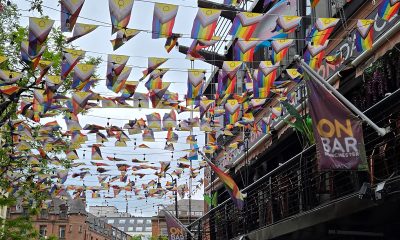
 Travel4 days ago
Travel4 days agoManchester is vibrant tapestry of culture, history, and Pride

